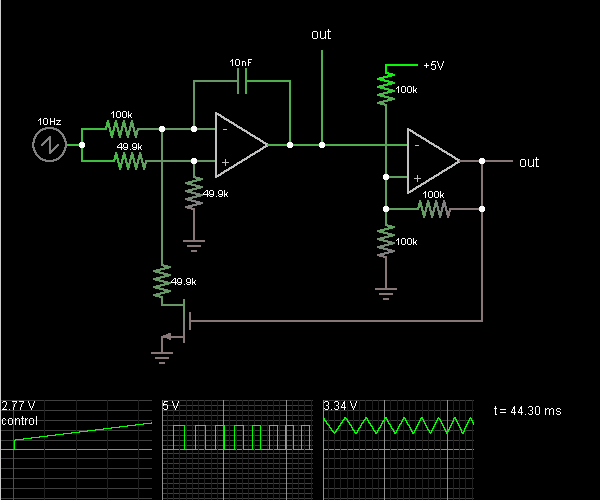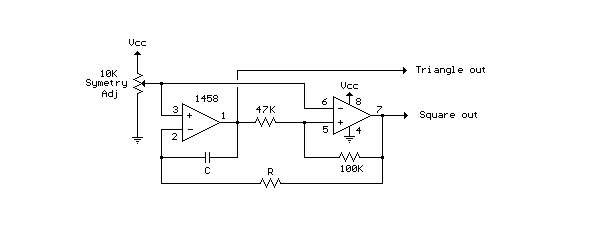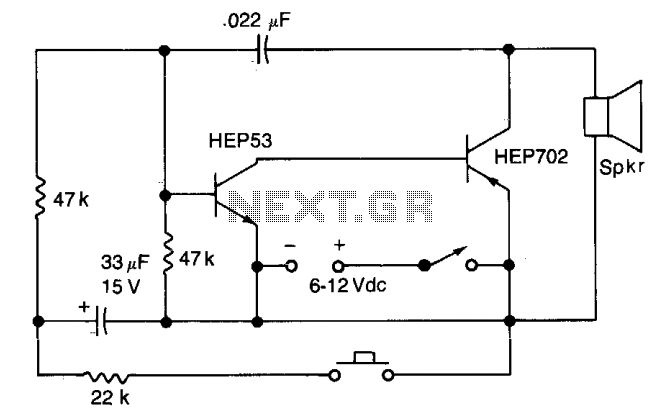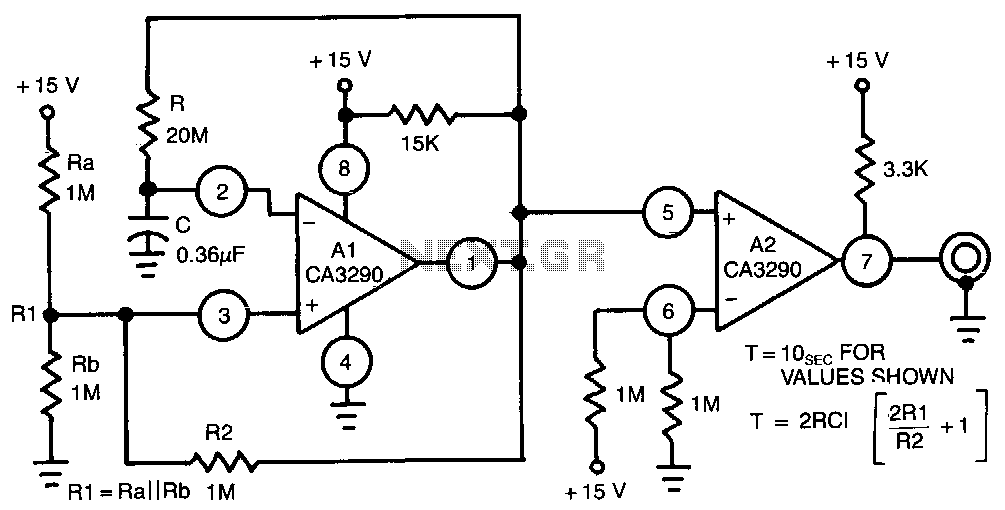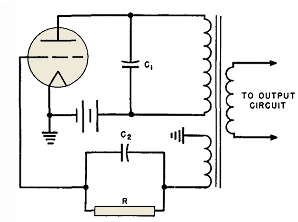
oscillator and frequency divider schematics
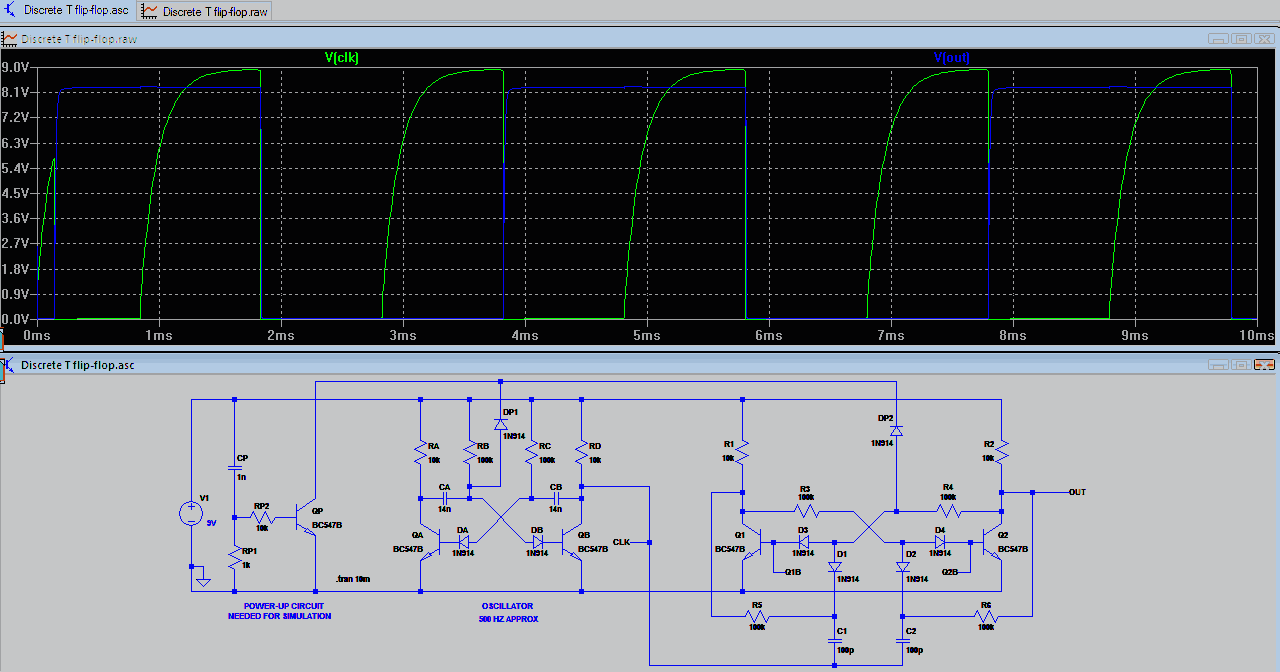
An idea proposed is to utilize a phase shift oscillator followed by an inverter to convert a sine wave into a square wave; however, this may be considered a rudimentary solution. There is also interest in schematics for a frequency divider. While it is known that a flip-flop can halve the frequency, only D flip-flops are typically seen used in this capacity. A simple circuit that can be constructed with discrete components for this purpose is being sought. A Schmitt trigger oscillator made from discrete components is suggested, where a feedback resistor would determine the frequency. Additionally, a control voltage through another resistor could be employed to vary it. The simplest known oscillator is a Schmitt trigger with a capacitor from the input to ground and a resistor from the output to the input, producing a square wave output. The 4093 IC can provide four oscillators, while the 40106 can provide six. An astable multivibrator is presented as a straightforward discrete solution, with a dual gang potentiometer used to adjust two resistances simultaneously, as adjusting two capacitances, especially in this circuit's size, is notably more challenging. Using frequency dividers ensures that octave frequencies remain synchronized. For a more intriguing note, a free phase organ with non-locked harmonics is suggested, which would require 60 oscillators for a 60-note keyboard. It is assumed that twelve oscillators will be used, one for each note, necessitating twelve CD4024 ICs to generate seven lower octaves from each oscillator. For a purely discrete approach with no integrated circuits, the schematic for a transistorized clock found on kabtronics.com is referenced, which employs two-transistor flip-flop circuits to divide frequencies by two, though it requires considerable space. The design utilizes PNP germanium alloy junction transistors powered by -12V; however, it is recommended to use NPN transistors operating at less than 6V due to the limited base/emitter voltage. The frequency divider circuit includes a sequential switching bistable multivibrator. In the oscillator, the value of R3 is contingent upon the load's current, which, in this scenario, is a series of frequency dividers. The critical nature of R3's value is questioned, with a recommendation for a current of approximately 1-10 mA, suggesting a resistance between 1k and 10k, such as 3.3k. The oscillator will not produce a square wave with a precise 50% duty cycle, which is often desired for an appropriate harmonic mixture. This issue can be mitigated by operating the oscillator at twice the highest desired frequency and taking the first output from the initial frequency divider, which inherently provides a 50% duty cycle. It is assumed that the "sequential switching bistable multivibrator" circuit will be used for the frequency divider, which is deemed effective despite the numerous components it contains, significant if many are to be built. The kabtronics design is noted as potentially simpler. The output of the transistor Schmitt oscillator is unlikely to achieve a 50% duty cycle due to the unequal distances of the switching thresholds from the supply rails, resulting in an uneven charging and discharging time for the capacitor. Generating a square wave with an exact 50% duty cycle is inherently challenging, with the divide-by-two stage being the most effective solution. If the duty cycle deviates from 50%, the frequency spectrum will encompass unrelated frequencies alongside the fundamental frequency and its harmonics.
A phase shift oscillator configuration can be utilized to generate sine waves, which can then be converted into square waves via an inverter. This method, while effective, may not be optimal for precision applications. The Schmitt trigger oscillator offers a more robust solution, particularly when built with discrete components. The feedback resistor in this configuration directly influences the frequency of oscillation, allowing for a straightforward method to vary the frequency through an additional control voltage applied via a resistor.
The core of the Schmitt trigger oscillator consists of a resistor-capacitor (RC) network, where the capacitor is connected from the input to ground, and the output is fed back into the input through a resistor. The output of this oscillator is a square wave, which can be adjusted for frequency by varying the resistor values. Integrated circuits like the 4093 or 40106 can be employed to create multiple oscillators, facilitating complex signal generation for applications such as musical synthesis.
In designing a frequency divider, the use of D flip-flops is common; however, alternative configurations utilizing bistable multivibrators can provide effective frequency division. The sequential switching bistable multivibrator circuit is particularly noted for its ability to halve the frequency of input signals. Careful consideration of component values, particularly resistors like R3, is crucial to ensure optimal performance. A typical design might aim for a current draw of 1-10 mA, with resistance values calculated based on the desired voltage supply.
When constructing these circuits, attention must be paid to duty cycle considerations, especially when generating square waves. A common approach to achieving a 50% duty cycle involves running the oscillator at double the target frequency and utilizing the output from the first frequency divider stage. This ensures that the output maintains the desired duty cycle, which is vital for applications requiring harmonic precision.
In summary, the combination of Schmitt trigger oscillators and frequency dividers can facilitate the creation of complex waveforms and signal processing tasks, particularly in sound synthesis applications. The careful selection of discrete components and circuit configurations is essential for achieving the desired performance characteristics.The other thing I thought of is using a phase shift oscillator followed by an inverter to turn the sine into a square wave, but it semms a rather crude solution. I`m also looking for the schematics to a frequencydivider. I know you can use a flip flop to halve the frequency, but I have only seen D flip flop used this way.
Is there a simple circuit that can easily be built with tiscrete components to do tha same thing I think a Schmitt trigger oscillator built with discrete components would work. The feedback resistor would set the frequency. You could even probably use a control voltage through another resistor to vary it. The simplest oscillator that I know is a Schmitt trigger with a capacitor from input to ground and a resistor from output to input. The output will be square wave. A 4093 will give four oscillators and a 40106, six. An astable multivibrator is a simple discrete solution. Use a 2 gang pot to adjust two resistances at once (it`s much harder to adjust 2 capacitances - especially of the size used in this sort of circuit) Using dividers means that the octave frequencies are locked to each other.
You may get a more interesting note if you use a free phase organ with non locked harmonics. This would entail 60 oscillators for a 60 note keyboard. As duke37 already suggested, you can use a CD4024 to generate seven lower octaves from each oscillator. (I`m assuming you will have twelve oscillators, one for each note, so you will need twelve CD4024s. ) If you really mean discrete, i. e. no ICs, look at the schematic for the transistorised clock on kabtronics. com. It uses two-transistor flip-flop circuits to divide frequencies by 2. As you can see, though, it takes a lot of space! Here is the heart of the Livingston Monarch. It uses pnp germanium alloy junction transistors and runs on -12V. Now, you should use npn transistors run on less than 6V, because of the limited base/emitter voltage.
And this is the frequency divider: (near the bottom, the squential switching bistable multivibrator) In the oscillator, the value of R3 depends on the current drawn by the load, which in this case is a chain of frequency dividers. Do you think this value is critical, as long as its not too high If it is, how can I calculate the current drawn The value of R3 isn`t critical.
I would choose a value that gives a current of around 1~10 mA, unless there`s some reason not to. So if your power supply is 9V, a value between about 1k and 10k will be fine. For example, 3k3. That oscillator will not produce a square wave with a duty cycle of exactly 50%. You probably want a 50% duty cycle to ensure the right mixture of harmonics. You can solve that problem by running the oscillator at twice the highest frequency you want, and taking your first output from the output of the first frequency divider. (The output from a frequency divider will always have a 50% duty cycle. ) For the frequency divider, I`m assuming you intend to use the "sequential switching bistable multivibrator" circuit.
This should work fine, but there are quite a few components in it, which is significant if you plan to build lots of them. Did you check out the kabtronics design It`s similar, but it might be a bit simpler. The reason why the transistor Schmitt oscillator`s output won`t be 50% is that the switching thresholds are not exactly the same distance away from the supply rails.
So the capacitor will take longer to charge to one threshold than it takes to discharge to the other threshold. It`s actually quite difficult to generate a square wave with a duty cycle of exactly 50%. The best way to do it is using a divide-by-two stage, as I suggested. If the duty cycle is not exactly 50%, the frequency spectrum will include unrelated frequencies as well as the fundamental and its ha
🔗 External reference
A phase shift oscillator configuration can be utilized to generate sine waves, which can then be converted into square waves via an inverter. This method, while effective, may not be optimal for precision applications. The Schmitt trigger oscillator offers a more robust solution, particularly when built with discrete components. The feedback resistor in this configuration directly influences the frequency of oscillation, allowing for a straightforward method to vary the frequency through an additional control voltage applied via a resistor.
The core of the Schmitt trigger oscillator consists of a resistor-capacitor (RC) network, where the capacitor is connected from the input to ground, and the output is fed back into the input through a resistor. The output of this oscillator is a square wave, which can be adjusted for frequency by varying the resistor values. Integrated circuits like the 4093 or 40106 can be employed to create multiple oscillators, facilitating complex signal generation for applications such as musical synthesis.
In designing a frequency divider, the use of D flip-flops is common; however, alternative configurations utilizing bistable multivibrators can provide effective frequency division. The sequential switching bistable multivibrator circuit is particularly noted for its ability to halve the frequency of input signals. Careful consideration of component values, particularly resistors like R3, is crucial to ensure optimal performance. A typical design might aim for a current draw of 1-10 mA, with resistance values calculated based on the desired voltage supply.
When constructing these circuits, attention must be paid to duty cycle considerations, especially when generating square waves. A common approach to achieving a 50% duty cycle involves running the oscillator at double the target frequency and utilizing the output from the first frequency divider stage. This ensures that the output maintains the desired duty cycle, which is vital for applications requiring harmonic precision.
In summary, the combination of Schmitt trigger oscillators and frequency dividers can facilitate the creation of complex waveforms and signal processing tasks, particularly in sound synthesis applications. The careful selection of discrete components and circuit configurations is essential for achieving the desired performance characteristics.The other thing I thought of is using a phase shift oscillator followed by an inverter to turn the sine into a square wave, but it semms a rather crude solution. I`m also looking for the schematics to a frequencydivider. I know you can use a flip flop to halve the frequency, but I have only seen D flip flop used this way.
Is there a simple circuit that can easily be built with tiscrete components to do tha same thing I think a Schmitt trigger oscillator built with discrete components would work. The feedback resistor would set the frequency. You could even probably use a control voltage through another resistor to vary it. The simplest oscillator that I know is a Schmitt trigger with a capacitor from input to ground and a resistor from output to input. The output will be square wave. A 4093 will give four oscillators and a 40106, six. An astable multivibrator is a simple discrete solution. Use a 2 gang pot to adjust two resistances at once (it`s much harder to adjust 2 capacitances - especially of the size used in this sort of circuit) Using dividers means that the octave frequencies are locked to each other.
You may get a more interesting note if you use a free phase organ with non locked harmonics. This would entail 60 oscillators for a 60 note keyboard. As duke37 already suggested, you can use a CD4024 to generate seven lower octaves from each oscillator. (I`m assuming you will have twelve oscillators, one for each note, so you will need twelve CD4024s. ) If you really mean discrete, i. e. no ICs, look at the schematic for the transistorised clock on kabtronics. com. It uses two-transistor flip-flop circuits to divide frequencies by 2. As you can see, though, it takes a lot of space! Here is the heart of the Livingston Monarch. It uses pnp germanium alloy junction transistors and runs on -12V. Now, you should use npn transistors run on less than 6V, because of the limited base/emitter voltage.
And this is the frequency divider: (near the bottom, the squential switching bistable multivibrator) In the oscillator, the value of R3 depends on the current drawn by the load, which in this case is a chain of frequency dividers. Do you think this value is critical, as long as its not too high If it is, how can I calculate the current drawn The value of R3 isn`t critical.
I would choose a value that gives a current of around 1~10 mA, unless there`s some reason not to. So if your power supply is 9V, a value between about 1k and 10k will be fine. For example, 3k3. That oscillator will not produce a square wave with a duty cycle of exactly 50%. You probably want a 50% duty cycle to ensure the right mixture of harmonics. You can solve that problem by running the oscillator at twice the highest frequency you want, and taking your first output from the output of the first frequency divider. (The output from a frequency divider will always have a 50% duty cycle. ) For the frequency divider, I`m assuming you intend to use the "sequential switching bistable multivibrator" circuit.
This should work fine, but there are quite a few components in it, which is significant if you plan to build lots of them. Did you check out the kabtronics design It`s similar, but it might be a bit simpler. The reason why the transistor Schmitt oscillator`s output won`t be 50% is that the switching thresholds are not exactly the same distance away from the supply rails.
So the capacitor will take longer to charge to one threshold than it takes to discharge to the other threshold. It`s actually quite difficult to generate a square wave with a duty cycle of exactly 50%. The best way to do it is using a divide-by-two stage, as I suggested. If the duty cycle is not exactly 50%, the frequency spectrum will include unrelated frequencies as well as the fundamental and its ha
🔗 External reference
